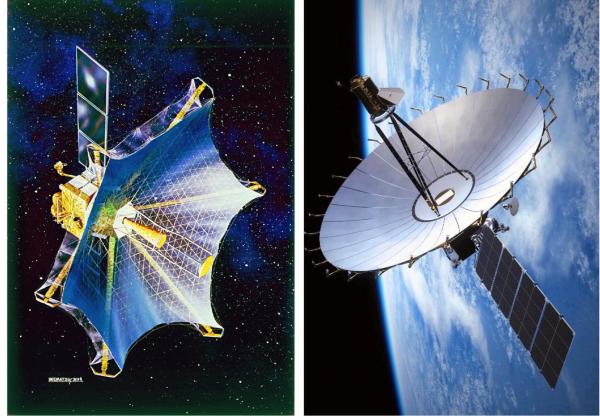
The past decade has seen leaps forward in both the scientific and technical expertise needed to conduct high resolution radio astronomy observations from space. Future detailed studies of compact celestial radio sources, related technologies and recent breakthroughs in the field are highlighted in a special issue of Advances in Space Research, entitled "High Resolution Space-Bourne Radio Astronomy".
The radio astronomy technique of Very Long Baseline Interferometry (VLBI) involves simultaneous observations of the same radio source by multiple widely separated telescopes. Data collected from each of these telescopes is correlated to produce a resultant radio image. In "traditional" VLBI, radio telescopes are distributed across the globe. The longer the distance between the observing telescopes - the baseline - the higher the resolution of the eventual image. Consequently, one of the limiting factors of traditional VLBI is the baseline that can be achieved between telescopes on Earth.
In 1997, the Institute of Space and Astronautical Science in Japan led an international collaboration, which placed the space-borne radio telescope HALCA in orbit. This was part of the VLBI Space Observatory Programme (VSOP) - the first dedicated Space VLBI (SVLBI) mission - which operated until 2003. In 2011, the next dedicated space VLBI mission RadioAstron, led by the Astro Space Center of Lebedev Physical Institute and Lavochkin Science and Production Association in Russia, advanced SVLBI by offering baselines comparable with the distance to the Moon. In 2019, RadioAstron completed its in-orbit operations. The VSOP and RadioAstron missions constituted the first generation of dedicated SVLBI instruments.
"The first generation SVLBI missions, VSOP and RadioAstron, created a unique de facto global collaboration of engineers and astronomers which acted as a team for several decades. While these missions brought about outstanding scientific results, no less impressive is the human dimension of widely international collaboration and spirit of friendship within the SVLBI team." Says Leonid Gurvits from the Joint Institute for VLBI ERIC and Delft University of Technology, and editor of a special issue of Advances in Space Research, entitled "High Resolution Space-Bourne Radio Astronomy".
The special issue offers a collection of papers covering the past, present and future of high-resolution radio astronomy employing the SVLBI technique. It addresses a broad range of scientific applications in extragalactic and galactic astrophysics, as well as experiments in fundamental physics. Several prospective concepts of future SVLBI missions in a broad range of wavelength domains, from kilometres to sub-millimetres are presented. In addition, the spirit of friendship and collaboration is reflected through a collection of sketches by David Jauncey of CSIRO (Australia), made over several decades at various SVLBI meetings around the world.
VLBI is arguably one of the most sophisticated techniques of modern observational astrophysics. The additional involvement of a space-borne radio telescope in a VLBI system brings even more challenges from the technological and operational perspective. It is only through the valuable contributions of large teams of scientists and engineers in SVLBI projects that such technological advances can be realised.
Special Issue link
High Resolution Space-Bourne Radio Astronomy. 2020. Special Issue: Advances in Space Research. v. 65(2): https://www.sciencedirect.com/journal/advances-in-space-research/vol/65/issue/2
Contact
Dr Gina Maffey
Joint Institute for VLBI ERIC (JIVE)
Email: maffey@jive.eu
Phone: +31 521 596 543
Prof. Leonid Gurvits
Joint Institute for VLBI ERIC (JIVE) and Delft University of Technology
Email: lgurvits@jive.eu
Phone: +31 629 015 149
Image credits
(Left panel) Highly Advanced Laboratory for Communication and Astronomy (HALCA) of the VLBI Space Observatory Program (VSOP). Credit: JAXA. (Right panel) Spektr-R spacecraft of the RadioAstron mission. Credit: Lavochkin Scientific and Production Association.
